General Plan
During our very first meetings as a group, we all became very inspired by Lewis Carroll’s Alice in Wonderland (AIW). Initially, we thought of re-creating a scene from this story in an immersive format. After Mengru joined our group, however, we decided to weld her idea of doing something related to the effects of climate change to our AIW idea.
As it stands now, we are planning on creating an audiovisual installation in which attendees experience the effects of climate change – in particular that of pollution – while still using AIW as an aesthetic and conceptual reference.
Basically, each attendee will enter a corridor, and as they make their way through it, the environment around them will begin to decay.
The beginning of the corridor will immerse the attendees in a tranquil, natural scene, e.g. an open field with the sounds of birds and insects. This will be expressed through projected visuals along the walls and loudspeakers scattered throughout the area. Then, gradually, pollution will infect the scene: visually (through 3d models of pollution superimposed on the visuals) and sonically (through the natural sounds being replaced by sounds of clanking garbage). These visual and sonic modulations will be triggered by the attendees (through Arduino sensors etc.) and performed live by members of our group (through MIDI controllers etc.)
We intend for attendees to leave the exhibition with all feelings of zest and vibrancy having been depleted.
motivations
Climate change is something that affects the entire planet, and since the members of our group span 3 distinct regions of the world (USA, India, and China), this is a topic to which we can all relate.
It is also a topic for which there exists a plethora of scientific data, which we can use to inform our creative choices (and, in the case of data sonification, precisely dictate them).
KEY WORDs
decay; deterioration; pollution; waste; barrenness; desolation; curious; fantastical; psychedelic;
location
Our ideal location would be the West Court room at ECA, because it has plenty of space and can feasibly be blacked out. Within this room, our plan would be to construct a standalone hallway for the attendees to move through.
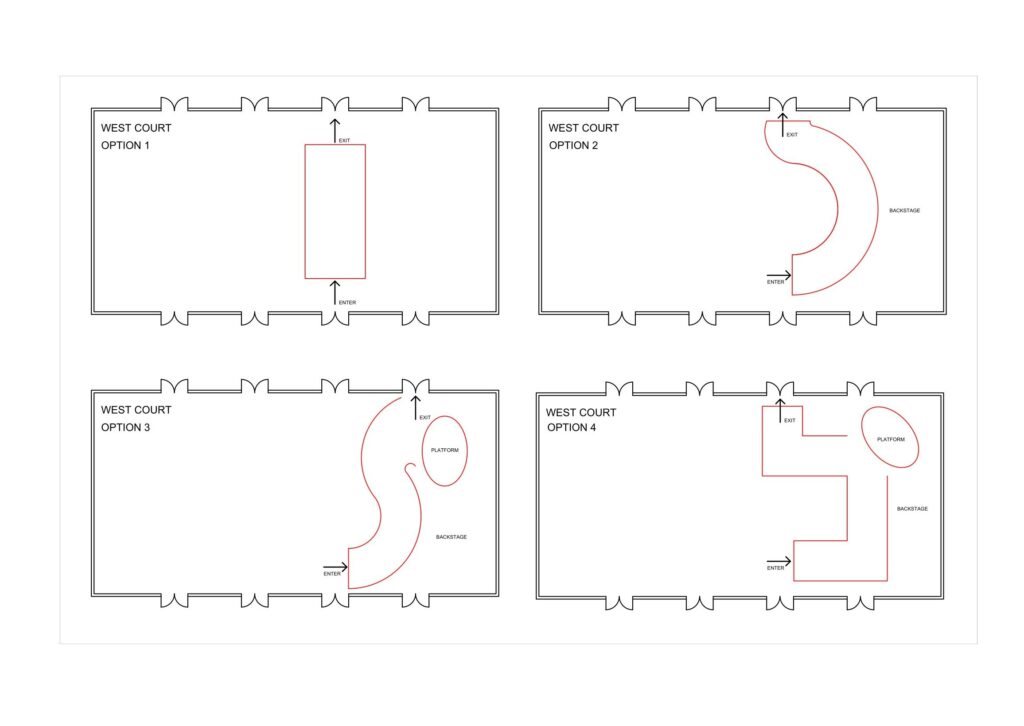
The above image shows a few ways in which the standalone hallway can be positioned. This could change based on what and how we want to display our performance. The main idea was to have the attendees enter through one door and exit through another.
Working Title
“Save me, Destroy me” is inspired by the notes in Alice in Wonderland which are attached to the drinks or cakes. These cakes and drinks are meant to make Alice shrink or grow, while the choices made by human being, or the attendees in this case, would make a difference to the environment as well.
Project Form
During the performance, the attendees would enter an Alice in Wasteland. They would be provided with Yes-or-No questions, and their choice would make a difference to the projected environment. Due to the influence level of their choices, the member of the group would perform differently through sound and visual, while all the difference will layer together instead of vanishing.
Audio
Recording:
Since the pollution could be one of the large problems that threaten the climate changing, the sound designers plan to do some recordings with wastes like plastic, metal, etc. As for the liquid pollution like oil, it is possible to use devices like playtronica to collect the sound as a sample. The recordings would be sent into samplers to produce a full range of notes, or become an effector for guitar or bass through coding or embedded programming.
Composition:
Due to the character of chords, we decided to perform major chords if the attendees make a “good choice”, while minor, inharmonic chords, or even noises for a “bad choice”. Since the question might lead to different kinds of pollution or impacts, the tune of the music will be sampled from the waste we use as mentioned above. As the attendee keeping going on the questions, the former sounds will maintain and the new sound will become another layer to join the whole composition.
Tech:
- ~6 loudspeakers on stands throughout the hallway (Genelecs rented from ECA Music Store)
- Max/MSP for generating and manipulating sound. This software can communicate with Arduino boards if we choose to use them. It also has the advantage of Jitter, which could be used to generate some of the visuals. It would be streamlined to have the sound and visuals being manipulated from the same piece of software.
- Ableton Live for additional sound generation and manipulation.
- MIDI keyboards and/or controllers for live sound manipulation. For example, the Akai MPD 24 that can be rented from the ECA Music Store:
- Analog instruments, e.g. Mengru plays bass, so she could definitely use that (combined with fx pedals) to add to the soundscape.
- If desired, there can be a few points at which attendees can walk up and put on a pair of headphones, if for example we have a localized and specific sonic experience that we wish to impart.
Visual
Environment: We’re asking ourselves what Alice in Wonderland truly is. Lewis Caroll spent years learning the way children’s minds functioned, and the innocence and imaginative freedom they possessed. We hope to create a similar peculiar and imaginative style in our audiovisual projections of pollution.
Tech:
- Arduino pressure sensors/USB dance mats based on availability: We can use this for the decision making parts of our game, where stepping onto the pressure sensor will trigger a question thus altering the audience’s experience.
- Adobe creative cloud and Maya: For creating motion graphics, illustrations and 3D models.
Moodboard:
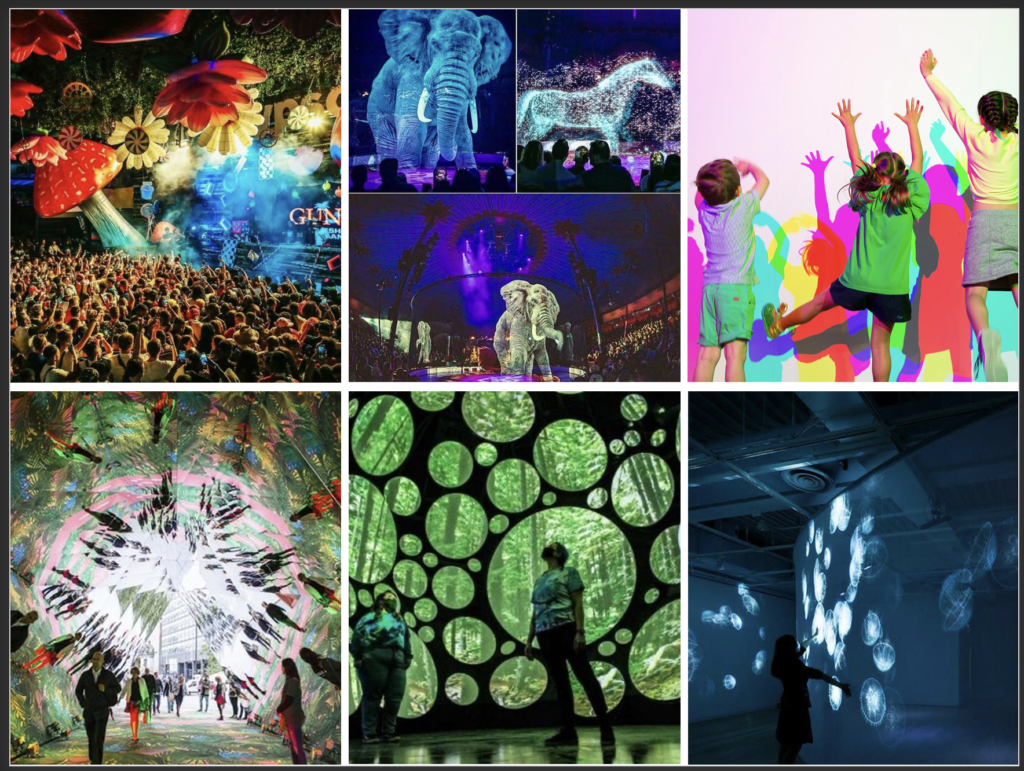
We hope to use the visual style of the flowers and the lighting style similar to these images. The moodboard serves as a visual aid for the nature projections, and a representation of our hallway based projection
Image source 1 | Image source 2 |Image source 3 | Image source 4 | Image source 5 | Image source 6
INSPIRATIONS
- Dismaland | 2015 | Banksy | Weston-super-Mare, England
This was an art installation that expressed various forms of environmental and societal decay. The feeling of dread imparted on attendees is something we are going for as well.

photo source - Sounding Climate | 2019 | National Center for Atmospheric Research | Colorado, USA
This was an exhibit that expressed some of the processes of climate change through sound. It is a solid reference for how to sonify this kind of data.
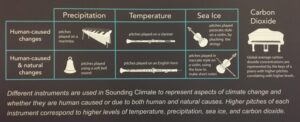
- Light Green Leaves with Light | 2013-2014 | Kyunggi Creation Center, Ansansi, Gyunggido
This exhibit creates a 3D projection using thin screens, using 3 blueray players, 3 6000ansi projectors, and 16 sets of screens. It’s an interesting alternative to holographic projections if we decide to use them for the central part of our performance.
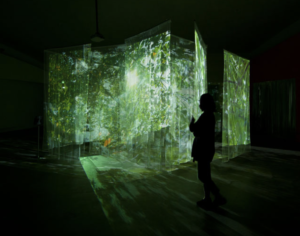
- Ocean Vortices | 2017 | Teamlabs | National gallery of Victoria
This is an interactive exhibit where movement and velocity causes changes in the visuals.
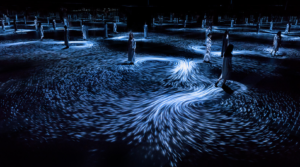
- Immersive Kelaidoscope | 2015 | Kiplings | London Sutton Walk, South Bank
This exhibit is of a kaleidoscope where people become part of the kaleidoscopic visuals being created. We could possibly do the same with a webcam and interlace it with fractals of garbage and garbage beings.
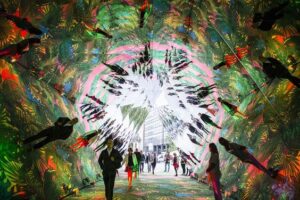
open questions
These are important questions that we are still mulling over as a group.
- What is the message we want to impart on attendees? Is our installation accusatory in the sense that we want attendees to feel blamed for the effects of climate change? Since that topic is not so straightforward, perhaps we should just raise awareness about these issues instead.
- What type of pollution should we target? Options include plastic, metal, greenhouse gases, and more. An obvious consideration here is which type of material lends itself to sonic and/or visual performance. Metal, for example, is generally much more resonant than plastic and therefore would be easier to incorporate into a soundtrack.
- Are we the only performers, are the audience performing, or is it some combination thereof?
- Should we prompt the attendees at the beginning of the corridor with some kind of question that dictates their experience? E.g. how much pollution do they want to see affecting the environment. Are the attendees then ‘performing’ part of the installation?
reference list
Aesthetic References
- Burton, T. (2010).,Alice in Wonderland, Walt Disney Studios Motion Pictures.
- Andrew, Stanton et al., WALL-E. Burbank, Calif., Walt Disney Home Entertainment, 2008.
- VanGoghAlive(2022)., [Exhibition], Festival Square, Edinburgh., 17th Marth 2022 – 17th July 2022., Available at: https://vangoghaliveuk.com/edinburgh/
- Garbage-punk:
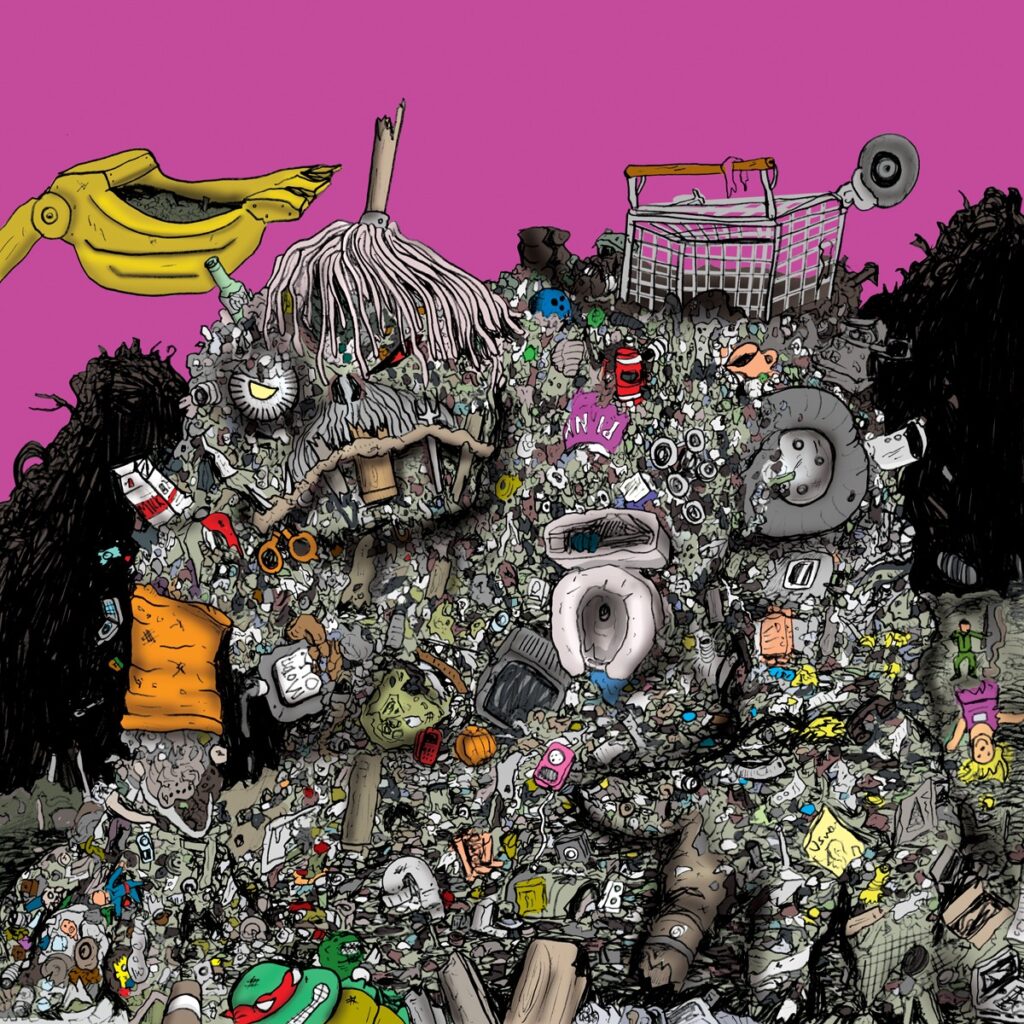
Climate Change References
- DACA
This is an organization that curates works of art built on climate change data. -
Griniuk, M. (2021) ‘Participatory Site-Specific Performance to Discuss Climate Change and Water Pollution’, Pluriversal Design Conference Series [Preprint]. Available at: https://dl.designresearchsociety.org/pluriversaldesign/pivot2021/researchpapers/42.This paper talks about performance art themed around climate change and water pollution.
Academic References
This is a book that explores the possibilities of sonification in the realm of data science.

